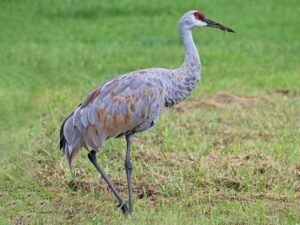
Greetings, subscribers. Today, in this series on Caring for Mother Nature, we learn about the leaping Sandhill Crane in a short essay by my friend, the naturalist and author, Peggy Sias Lantz. Enjoy!
Photo from: https://www.allaboutbirds.org/guide/Sandhill_Crane/photo-gallery/303217321
The Sandhill Crane
by Peggy Lantz
Recently, I saw our resident pair of Sandhill Cranes standing near the edge of Good Homes Road [near Peggy’s house in Florida], and at their feet was a young Sandhill chick! A pair of Sandhill Cranes have been residents of Woodsmere – the area around Lake Lucy and Lake Florence where I live – for many years [and evidently they recently had a baby]. They nest in the wetlands surrounding these two lakes, but have not successfully raised a chick in a long time. I suspect that coyotes or bobcats, which also live here, are responsible. I’ve lost chickens to both of these predators.
Sandhill Cranes are large birds, standing nearly four feet tall. Their feathers are brownish-gray, with an unfeathered red crown and white cheeks. Their call is a raucous clacking. I’ve seen them dancing at my lakefront, throwing their heads back, bowing, and leaping into the air.
Crane parenting
They hide their bulky nest of sticks, pickerelweed, and grasses close to the water. Sometimes a heavy rain will float it, giving it a bit more protection from predators. They nest from January to June and share brooding duties. The eggs take about 30 days to hatch, and the chicks are precocial, meaning they are born with feathers and with their eyes open, so they can move around and leave the nest if necessary to hide or run. (Baby birds that are born blind and featherless, like most of our songbirds, are called altricial.)
The chick I saw recently was about a foot tall, yellow and fluffy, with a long neck and long legs. It will stay with its parents for the better part of a year, about ten months.
Crane diet, flight pattern, name origin, and more
Sandhill cranes eat a varied diet – invertebrates (that’s bugs and worms and insects – things without a backbone), small critters, water plants, berries – all kinds of things, mostly on land. I don’t see them wading or fishing, but my book says they do.
Our local cranes are very tolerant of people and cars. So, we drive carefully when they are standing in the road while they walk slowly and with great dignity out of the way.
We have a few migratory Sandhill Cranes come to Woodsmere for the winter most years, but large migratory flocks spend the winter in Paynes Prairie near Gainesville, Florida.
Large flocks of them stop on the Platte River in Nebraska and travel on to southern Texas and central Mexico. The sandhill part of their name is because of their famous stopover along the sandy Platte River in Nebraska.
Sandhill Cranes are listed as “Threatened” on Florida’s Endangered Species List. I do hope our youngster survives the predators.
—END—
Thanks for reading!
Your writer on the wing (no relation to the Sandhill Crane),
Charlene







Winkler Myra
Loved the article on the sandhill crane. I see several families of them at different locations on my bike rides on the Seminole Trail. MW~
Charlene
Hi Myra,
Once at the airport waiting-for-family-to-arrive parking lot, I watched a whole group of these cranes strolling around, keeping an eye on us.
Janne Lane
I loved the article about the sandhill crane. I wonder if one of the birds we used to see on Lake Virginia was one of these.